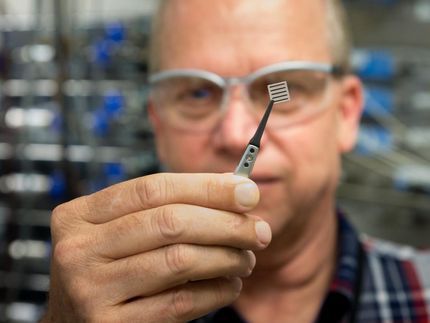Research cooperation: Saint-Gobain and Novaled announce a breakthrough in glass substrates for OLED
Saint-Gobain and Novaled have demonstrated the feasibility of large area OLEDs, based on a new high-performance metallic anode, with Saint-Gobain Recherche technology and Novaled OLED proprietary developments.
The goal of a two-year research cooperation programme between both partners has been to develop basic technologies for high-performance white OLEDs. Researchers at Saint-Gobain Recherche (SGR) have created a highly conductive transparent electrode "Silverduct(TM)", bringing up to 10 times better surface conductivity than traditional ITO (Indium Tin Oxide). Thanks to Novaled PIN OLED(TM) technology for high efficiency OLEDs, samples were successfully manufactured on large area surfaces. SGR and Novaled now see the possibility to produce homogeneous OLED devices up to 100 cm² which will ease the manufacturing of large OLED lighting products.
Traditional ITO coated glass impedes the race to large area OLED, due to its limited ability to carry current over distances longer than a couple of centimetres. Therefore, for large area OLEDs, the ITO layer must be topped with a thick metallic grid to prevent gradient of light emission caused by the sheet resistance of ITO alone (typically 30 Ohm/sq). The new anode Silverduct(TM) has a sheet resistance of less than 4 Ohm/sq, thus enabling large area OLEDs without additional metal grids. This is an important step especially for transparent and bottom emission OLEDs in which the metal grid is visible. Additionally, by eliminating the metal grid Silverduct(TM) offers significant potential for reducing manufacturing costs.
Organizations
Other news from the department research and development

Get the chemical industry in your inbox
By submitting this form you agree that LUMITOS AG will send you the newsletter(s) selected above by email. Your data will not be passed on to third parties. Your data will be stored and processed in accordance with our data protection regulations. LUMITOS may contact you by email for the purpose of advertising or market and opinion surveys. You can revoke your consent at any time without giving reasons to LUMITOS AG, Ernst-Augustin-Str. 2, 12489 Berlin, Germany or by e-mail at revoke@lumitos.com with effect for the future. In addition, each email contains a link to unsubscribe from the corresponding newsletter.




























































